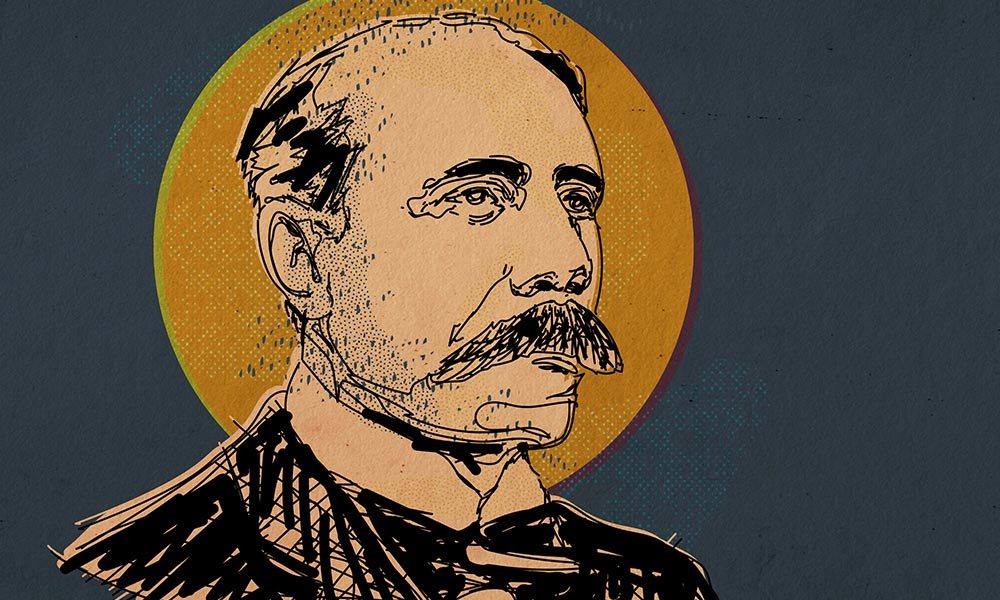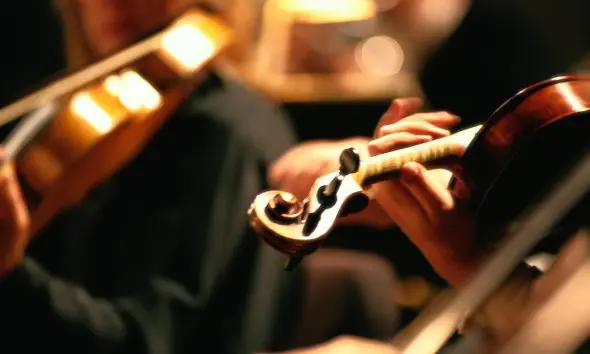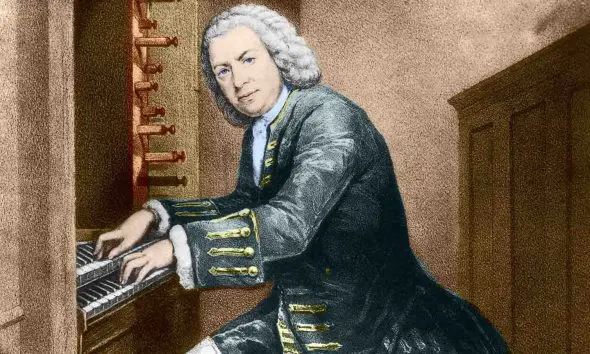Elgar’s ‘Enigma Variations’: The Mystery Behind The Masterpiece
Discover the unsolved mystery behind Elgar’s ‘Enigma Variations’ which established his international reputation.

It was Elgar’s Enigma Variations (or Variations On An Original Theme to use its original title) that catapulted Elgar to international renown. And it came relatively late in life, when the composer was in his early forties. Elgar composed his Enigma Variations between October 1898 and February 1899 and the work premiered in London on June 19, 1899.
Why ‘Enigma’? Because Elgar was secretive about the work’s theme. And the theme was not a straightforward theme in itself. Listening to it you hear syncopations which almost seem to suggest that, to quote the composer, “over the whole set another and larger theme ‘goes’, but is not played …so, the principal Theme never appears”. And more, “The Enigma I will not explain – its ‘dark saying’ must be left unguessed”. Well, there’s nothing like telling your audience that there’s a secret, it’s dark, it’s not entirely clear and it “must be left unguessed”, to get them to do precisely the opposite – try and solve the mystery. Like telling a naughty child not to do something. What happens? It has another go at that forbidden thing.
Listen to Elgar’s Enigma Variations on Apple Music and Spotify.
Elgar’s Enigma Variations: The mystery behind the masterpiece
During the 120 years or so that have elapsed since Elgar’s Enigma Variations were written, all manner of suggestions have been made as to what the mysterious theme is. Mozart’s ‘Prague’ Symphony, whose slow movement fluctuates between G minor and G major (like the Enigma’s theme itself) is one; Elgar had only recently heard a performance in Leeds. After Elgar’s death in 1934, it was suggested that the possible ‘countermelody’ (the ‘theme’ that ‘goes, but is not played’) could be Auld Lang Syne. Was this a veiled reference to the close of the nineteenth century, given the work was completed in 1899? Was it about ‘old acquaintances’, given that the Enigma Variations is a musical essay about friendship? It seems Elgar himself disagreed, and that he is on record as saying that “Auld Lang Syne won’t do”.
So the guessing continued: the minor version of Twinkle, Twinkle Little Star; God Save The Queen; Martin Luther’s hymn tune Ein Feste Burg; Home, Sweet Home; Rule Britannia; the theme of the slow movement of Beethoven’s ‘Pathétique’ Sonata; Pop Goes The Weasel; and as recently as May 2019 it was announced that the mystery had been solved. Ed Newton-Rex, a composer and alumnus of the Choir of King’s College Cambridge, is confident that it is Pergolesi’s Stabat Mater.
And so the theme has been inverted, reversed, and carved up in all manner of form, pulled apart, dissected, put back together again. But still no definitive answers.
It may be that the answer to the riddle is staring at us in the face. After all, wasn’t it Sherlock Holmes who said that the best place to put something where you don’t want someone to see it is right in front of their eyes? Or perhaps, the clue, the theme, isn’t musical at all. In his book on Elgar, Ian Parrott suggests the theme has a biblical source. It’s also been suggested that the theme is Shakespeare’s 66th sonnet. In 2010 Charles and Matthew Santa proposed the theory that the enigma was based on pi.
Dedicated “…to my friends pictured within”
The Enigma Variations are sketches of friends. In fact, the work was dedicated “…to my friends pictured within”. So perhaps the theme is simply (or profoundly) one about friendship. When Debussy wrote his Préludes, he gave them titles after he had written them. When Elgar wrote his Enigma Variations each section was headed with the initials of friends, with the final variation, No. 14, called ‘E.D.U.’ – Edu being his wife Alice’s nickname for her husband. And it is to Alice herself that the first variation ‘C.A.E.’ is dedicated.
Elgar’s Enigma Variations also spell out, in musical ways, characteristics of the friends. So Hew David Steuart-Powell would ride through town on his bicycle, constantly ringing the bell – the pizzicato violins doubled by woodwinds neatly represent the bell. Variation 10 is Dorabella, who is step-niece of Variation 4, as it were (Billy Baker); she spoke with a slight stammer and you can hear it in the music.
Variation 11, is headed ‘G.R.S’ (organist George Robertson Sinclair) but the rambunctious music for this variation is a portrait of Dan, Sinclair’s bulldog, complete with furious paddling upstream and a satisfied bark upon landing. Later, we get an enigma within the Enigma: ‘***Romanza’ is the title of Variation 13, and Elgar explained that the asterisks represented the name of a lady (Lady Mary Lygon) who, at the time, was on a sea voyage with her brother to Australia, who was to become Governor of New South Wales. Here, Elgar quotes beautifully from Mendelssohn’s Overture Calm Sea and Prosperous Voyage – and perhaps a phrase from the Mendelssohn, heard in the clarinet, has never been more poignantly played or recorded than in Sir Charles Mackerras’s (another Australian) recording with the Royal Philharmonic Orchestra.
‘Nimrod’ – Variation 9
But at the heart of Elgar’s Enigma Variations, Variation 9 to be precise, lies one of the most moving passages in all of Western Classical music. It’s a portrait of his friend, A.E. Jaeger. It’s not called ‘A.E.J’, as you might expect, but rather ‘Nimrod’. Jaeger worked for the publishing house of Novello, and was a staunch friend to the composer, in good times and in challenging ones. Elgar mentioned that the variation was a portrait of a long summer evening talk, “when my friend discoursed eloquently on the slow movements of Beethoven”. But why ‘Nimrod’? Because ‘Jaeger’ was German, and in German ‘Jaeger’ means ‘hunter’. Nimrod was the ‘mighty hunter’ mentioned in the Bible (Genesis: 10).
Not surprisingly, Elgar himself used ‘Nimrod’ in other works, notably and memorably in his vastly underrated and underperformed oratorio The Music Makers (another autobiographical work where the composer brings back themes from many of his previous compositions).
It is perhaps the variation closest to the theme itself. Like any music of a personal nature, it means different things to different people, but its nobleness has made it perfect for use on solemn occasions. ‘Nimrod’ has regularly been performed at Whitehall in London at the National Service of Remembrance. A version with floating wordless soprano solo (and very slowed-down) was used in the soundtrack to the 1998 British biographical drama film Elizabeth (which angered the Elgar estate at the time) and you can hear an adaptation of it at the end of the 2017 film Dunkirk.
‘Nimrod’ was performed at funeral of Diana, Princess of Wales
‘Nimrod’ was performed on 6 September 1997 at the service of the funeral of Diana, Princess of Wales. Her brother, the Earl Spencer, perhaps alluded to the inclusion of ‘Nimrod’ (and its hunter associations in the original work), bitterly and poignantly, when in his speech on the occasion he said: “It is a point to remember that of all the ironies about Diana, perhaps the greatest was this – a girl given the name of the ancient goddess of hunting was, in the end, the most hunted person of the modern age”.
Is it, perhaps, a coincidence that Sheku Kanneh-Mason, who performed at the happier occasion of the wedding of Princess Diana’s second child, Harry, to Meghan Markle, included ‘Nimrod’ on his album, Elgar, centred around Elgar’s Cello Concerto? That in itself may be an enigma, but the music itself is a lasting testament to Elgar’s work, that it will withstand all good transcriptions, especially when so movingly performed as by Sheku on his Elgar recording.
Recommended Recordings
Rightfully, virtually all of Sir Adrian Boult’s recordings of Elgar’s masterpiece have been praised. Boult knew the composer, after all, and championed his music throughout his life. Mackerras’s aforementioned RPO recording is one of the work’s most cherishable. But perhaps the hidden gem among the sixty-plus recordings that have been made of Elgar’s Enigma Variations is that by the Royal Philharmonic conducted by Norman Del Mar. It enshrines Elgar’s beloved ‘nobilmente’ sentiment, but is noble without ever becoming sentimental, movingly performed, and magnificently recorded.





Steve Marlow
July 8, 2020 at 11:49 am
A good summary of one of the greatest musical masterpieces. You might like to explore a new idea about the famous enigma, which co-incidentally I started to develop around the time this article was published and which makes more sense the more I find out – https://sdmarlowmusic.net/enigma/